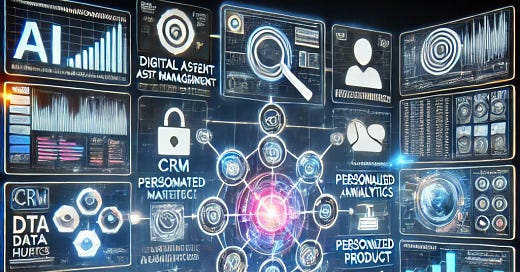The Intersection of Digital Asset Management, CRM, and E-commerce: A Future-State Vision
Success in the digital age isn't just about managing assets, customers, or transactions in isolation—it's about integrating them seamlessly to deliver personalized, real-time experiences that drive both engagement and revenue.
In today’s fast-paced digital landscape, businesses increasingly depend on three essential systems to drive customer engagement and sales: Digital Asset Management (DAM), Customer Relationship Management (CRM), and E-commerce platforms. While these tools deliver value individually, the true game-changer lies in their integration. This article presents a future-state vision where DAM, CRM, and E-commerce platforms converge into a unified, data-driven ecosystem powered by advanced AI and real-time insights, offering personalized customer experiences at scale.
Current State: Fragmentation Hinders Opportunity
1. Digital Asset Management (DAM)
DAM systems allow organizations to manage, organize, and distribute vast libraries of digital content like images, videos, and documents. However, despite their importance, these systems often operate in isolation, disconnected from customer data and real-time insights that could enhance personalization.
Key Challenge: Without integration into CRM and E-commerce platforms, DAM systems often deliver static, one-size-fits-all content, missing the opportunity to align assets with customer preferences or behaviors in real-time.
2. Customer Relationship Management (CRM)
CRM platforms manage customer data, from contact details to interaction histories, helping businesses track and engage customers throughout their lifecycle. Despite this, CRMs often fail to turn raw data into actionable insights across the entire customer journey.
Key Challenge: Data fragmentation remains a significant issue, as critical customer data is spread across disconnected platforms. This makes it difficult to deliver personalized marketing and sales experiences that reflect customer behaviors in real time.
3. E-commerce Platforms
E-commerce platforms are the digital storefronts where customers engage, browse, and buy products. While they handle core functions like product listings and sales, many struggle to offer truly personalized experiences based on customer data from CRMs or dynamic content from DAM systems.
Key Challenge: Without seamless integration with CRM and DAM, e-commerce platforms often rely on generic data and historical trends, limiting their ability to adapt quickly to individual customer behaviors and preferences.
Reaction: The Growing Demand for Personalization and Integration
As digital transformation accelerates, businesses face increased pressure to deliver personalized, real-time experiences that cater to individual customer needs. Several key drivers are fueling this demand:
Customer Expectations: Today’s consumers expect a tailored experience, whether they are browsing an e-commerce site, engaging on social media, or receiving marketing emails. Irrelevant content can lead to disengagement or lost sales.
Competitive Pressure: E-commerce leaders like Amazon and Shopify have set the bar for real-time, personalized experiences, pushing other businesses to adopt more sophisticated systems or risk falling behind.
Data Privacy and Compliance: As regulations like GDPR and CCPA impose stricter controls on data usage, businesses must navigate the challenge of maintaining compliance while still delivering personalized content and experiences.
With the stakes higher than ever, businesses can no longer afford to maintain siloed systems. A future-state vision of unified DAM, CRM, and E-commerce platforms is necessary to meet customer demands, stay competitive, and maintain compliance.
Future State: A Unified, AI-Powered Ecosystem
The future lies in the full integration of DAM, CRM, and E-commerce platforms into a seamless, AI-driven ecosystem. Here’s what this future looks like:
1. AI-Driven Content Personalization
In the future, DAM systems will not only manage assets but also leverage AI and machine learning to serve personalized content to customers in real time. By integrating with CRM and E-commerce platforms, DAM systems will analyze customer profiles, interaction histories, and real-time behaviors to deliver personalized images, videos, and promotions.
Example: Imagine a returning customer visits an online clothing store. Based on their browsing history and purchase patterns, the DAM system dynamically presents eco-friendly fashion options, accompanied by promotional banners aligned with their preferences—making each interaction personal and relevant.
2. Unified Customer Data and Real-Time Insights
CRM systems will act as the central hub for customer data, seamlessly connected with DAM and E-commerce platforms. Data fragmentation will become a thing of the past, allowing businesses to gain a 360-degree view of the customer. AI-driven analytics will continuously process real-time data, enabling predictions of customer behaviors and preferences.
Example: A CRM system notices that a customer abandoned a cart after browsing a high-ticket item. It triggers a personalized email campaign offering a discount on that product, using images and videos from the DAM system that highlight the product’s premium features.
3. Seamless E-commerce Personalization
E-commerce platforms will evolve into AI-powered recommendation engines that seamlessly integrate DAM and CRM data. Product recommendations, promotions, and content will adjust in real time based on individual customer behaviors and preferences.
Example: As a customer browses an outdoor gear store, the platform automatically adjusts product descriptions and images to highlight sustainability features, based on their history of purchasing eco-friendly items. This not only enhances the shopping experience but also increases conversion rates.
4. Privacy-First Personalization
In this future, businesses will balance personalization with data privacy. AI and machine learning models will process anonymized customer data to ensure compliance with regulations like GDPR and CCPA, while still delivering relevant, personalized content.
Example: Businesses will create personalized experiences without directly accessing sensitive customer data. Instead, behavioral patterns and preferences will be used to generate content tailored to each customer, ensuring a privacy-first approach while maximizing engagement.
Case Study: Transforming Customer Experience with Integration
Let’s take Brand X, a mid-sized online retailer struggling with siloed systems. By integrating their DAM, CRM, and E-commerce platforms, they transformed their customer experience. Now, every time a customer engages with their site, they are greeted with content, promotions, and product recommendations personalized to their preferences.
For example, by connecting their CRM’s behavioral data with their DAM’s dynamic asset delivery, Brand X achieved a 20% increase in conversion rates and a 30% boost in customer engagement within just six months. Meanwhile, their AI-powered e-commerce engine streamlined customer journeys by serving real-time product recommendations tailored to each shopper’s behavior.
This case study highlights the potential for businesses of all sizes to unlock the full power of a unified, AI-driven ecosystem.
Strategic Benefits of the Unified Ecosystem
1. Enhanced Customer Engagement and Loyalty
AI-driven personalization will ensure customers are constantly presented with relevant, timely content, leading to increased engagement and stronger brand loyalty.
2. Operational Efficiency
Automation across DAM, CRM, and E-commerce platforms will reduce manual intervention, freeing up resources to focus on strategy, innovation, and customer-centric initiatives.
3. Higher Conversion Rates and Revenue Growth
Personalized product recommendations, content, and promotions will lead to increased conversion rates, boosting revenue and driving long-term growth.
4. Privacy Compliance
By ensuring anonymized data processing, businesses will be well-prepared to navigate current and future data privacy regulations, minimizing risk while maximizing personalization.
Conclusion: The Path Forward
The future of digital business lies in the seamless integration of DAM, CRM, and E-commerce platforms, powered by AI and machine learning. Businesses that embrace this vision will gain a competitive edge by offering deeply personalized, data-driven experiences that engage customers, drive operational efficiency, and grow revenue—all while adhering to the highest data privacy standards.
Now is the time to take action. Businesses should evaluate their current digital infrastructure, identify opportunities for integration, and implement the tools necessary to build a unified, real-time customer experience. Those that do will thrive in tomorrow’s marketplace—those that don’t risk falling behind.
Call to Action:
Hierarchical data models no longer meet the demands of the future. To deliver the personalized, real-time experiences your customers expect, your data needs to be relational, anonymized, and structured in vector databases. The transformation starts at the data level—ensuring that your systems are integrated, secure, and ready for advanced analytics.
Talk to The DAM Playbook team for a comprehensive data evaluation and learn how to reshape your infrastructure for the future.










Share this post